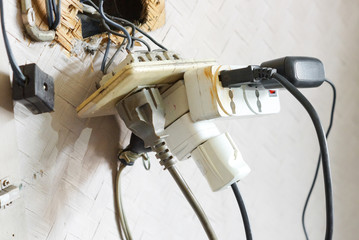
It would be best if you considered damaged power outlets as an emergency fix. There are a lot of reasons for this. If you live in a rural area, chances are you don’t have any electrical supply whatsoever, and that’s going to leave you without power. Whether you are using it for an extension or for lighting your home, you must have a source of power.
First, before you can even think about repairing it, you need to find damaged power outlets. The first place to check would be the wall outlet, or at least where your plug-in goes. It will either be loose or in the process of being removed. In fact, if you have one of those newer plugs in systems, the damage probably won’t show up on the appliance itself. You have to physically take it to a service center and have it fixed, but some older ones may not.
Once you have the outlet replaced, then take a look at the plug. Is the plug completely loose? If so, take it back to the retailer or manufacturer and have it replaced.
Second, ask Electrician Cleveland if he has any plugs you can replace. Some companies have different requirements than others, so they might actually have replacement plugs available. Even if they do not, there are still other ways to fix the problem.
The first thing you can do is to take the old outlets out and clean them. You can’t just use any cleaner, though. Make sure you use something like a wire cleaner specifically designed for all types of outlet covers. This will not only get rid of residue, but it will also make sure nothing else gets into the outlet.
Take the new ones and stick them into the damaged locations. Be careful when doing this. Many people try to slide the covers in without taking the proper precautions. They might actually hurt themselves and possibly damage more than just the power outlets. Try pushing each one slowly in to see where it fits. If you are not sure, take a screwdriver to each slot to give yourself some more leverage.
If this doesn’t work, you will need to take your old outlet and cut it back to size. You can either use a utility knife or a pair of wire cutters. Make sure you use the appropriate cutting tool, as you don’t want anything to come loose and catch fire.
One final way to fix your damaged power outlets is to have your circuit breaker replaced. Circuit breakers are the basic backup for most home electrical systems. They should be inspected regularly by a licensed electrician so that they work at their very best. If you have any broken bones, you should immediately call an electrician to make sure they are working correctly. They will be able to replace them with new ones in no time at all.
If none of these methods work, then you should try cutting out the power from the outlets. You will have to open the breaker box that the outlet is connected to, which usually can be done with an opener for the front door. If this doesn’t work, you will need to turn the power off to the house. Once the power has been turned off, try plugging the outlets back in. If you are not sure how to do this, your local electrician can usually point you in the right direction to do so.
When trying to fix damaged power outlets, you should remember because sometimes you will have to replace the outlet with another one. Some older homes may have only two power outlets, which can be enough to handle small appliances such as a hairdryer and a small stereo system without much trouble. But if your home is newer, you may need three or more outlets to handle a large electronics system. If you cannot afford to get a completely new outlet installed, you can always ask your HVAC contractor to refer you to someone that can help you with this problem.
Another option for replacing a damaged outlet is to modify the wiring on the wall itself. You could make the connection between the damaged appliance and the power socket, or you may need to move it closer to the wall to provide it with a safe distance. Sometimes, all you need to do is add a short circuit to the existing wiring. This is not very difficult to perform, and if you try it yourself, you may end up with a straightforward repair that can also protect you from further electrical damage.
If none of these methods work, you should consult your HVAC contractor and have him or her replace the outlet with a new one. This should be no more expensive than having the damaged outlet replaced, and it may even be a good choice if it can be done in a timely fashion. It is always best to have your HVAC system inspected for problems before winter comes around, so you will know what kind of outlet you need to avoid the need for emergency power. In the meantime, you can have the old one replaced with a working one and enjoy the protection it can give your home.
